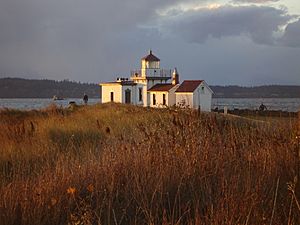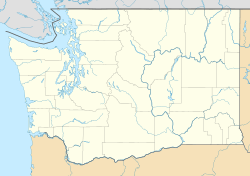West Point Light facts for kids
 |
|
|
|
|
| Location | Seattle, Washington |
|---|---|
| Coordinates | 47°39′42″N 122°26′08″W / 47.66167°N 122.43556°W |
| Year first constructed | 1881 |
| Year first lit | 1881 |
| Automated | 1985 |
| Foundation | Natural/emplaced |
| Construction | Brick with stucco |
| Tower shape | Square |
| Markings / pattern | White |
| Focal height | |
| Original lens | Fourth order Fresnel lens |
| Current lens | VRB-25 |
| Range | White 16 nautical miles (30 km; 18 mi), Red 13 nautical miles (24 km; 15 mi) |
| Characteristic | Alt WR 10s |
| Fog signal | Horn: 1 every 10s, activated for 30 minutes by keying a mike 5 times on VHF channel 78A |
| USCG number | 6-16800 |
The West Point Light, also called the Discovery Park Lighthouse, helps ships find their way in the water. It stands on West Point in Seattle, Washington. This point sticks out into Puget Sound and marks the top part of Elliott Bay. The lighthouse looks a lot like the Point No Point Light. In 1977, it was added to the National Register of Historic Places, which means it's an important historical site. Today, it's a key part of Seattle's Discovery Park.
Contents
History of the Lighthouse
The West Point Light is about 23-foot-high (7.0 m). It started working on November 15, 1881. This lighthouse used a special Fresnel lens to make its light bright. It was the very first lighthouse on Puget Sound to have people living and working there. Building it cost about $25,000 back then.
Lighting Up the Way
For its first 44 years, the lighthouse used a kerosene lamp to shine its light. Kerosene is a type of fuel. In 1926, the lighthouse got connected to Seattle's electricity. This made it much easier to power the light.
Becoming Automated
In 1985, the West Point Light became "automated." This means machines took over the job of turning the light on and off. It was the last lighthouse in Washington to become automated.
New Owners and Upgrades
In 2003, the City of Seattle's Department of Parks and Recreation wanted to take care of the lighthouse. They asked the United States Department of the Interior to let them have it. The city got the lighthouse property in October 2004.
When the city took over, the U.S. Coast Guard changed the old lighting system. They put in a modern Vega Rotating Beacon, called a VRB-25. The light still flashes red and white every five seconds, just like it always did.
Restoring a Landmark
A big project to fix up the lighthouse started in 2009. It cost about $600,000. The outside of the lighthouse was finished in 2010. The living areas for the lighthouse keepers were restored in 2011.


